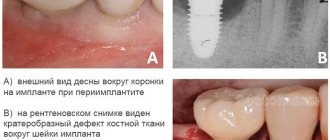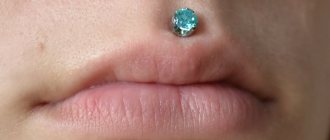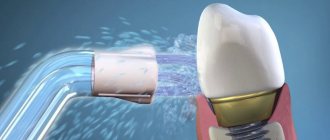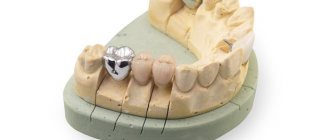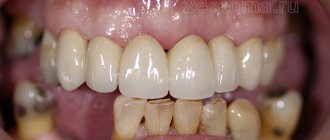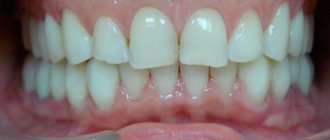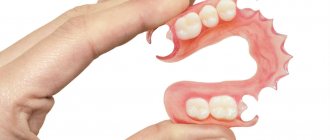From this article you will learn:
- pros and cons of ceramic zirconium crowns,
- their varieties - “Multi-layer”, monolithic, etc.,
- how much does a zirconium crown cost for 2022.
Zirconium crowns are a variant of dental crowns for restoring damaged and missing teeth, the material of which is zirconium dioxide (ZrO2). This material belongs to metal-free ceramics. Unlike metal-ceramics, zirconium dioxide crowns do not have a metal frame inside, which makes it possible to achieve a higher level of aesthetics in dental prosthetics (compared to metal-ceramic crowns).
Zirconium crowns also have very high strength. They are considered to be at least 2-4 times stronger than crowns made from other types of metal-free ceramics (for example, porcelain crowns). But all this is true only for crowns that are made of monolithic zirconium dioxide. In most cases, only the internal frame is milled from zirconium dioxide, on top of which layers of porcelain mass are applied. This allows you to achieve a higher level of aesthetics, but on the other hand, it increases the risk of chipping.
Zirconium crowns: photo
However, in recent years, a new technology for manufacturing zirconium crowns has emerged, which is called “Multi-layer”. This technology makes it possible to produce crowns from monolithic zirconia (i.e., without applying a surface layer of porcelain), and at the same time obtain esthetics almost comparable to the most esthetic types of metal-free ceramics, for example, crowns made of feldspathic porcelain or IPS E-max ceramics.
All this became possible thanks to the emergence of modern versions of zirconium dioxide blocks (disks), which are made using the “multi-layer” technology and also have high transparency (translucency characteristic of natural tooth enamel). In this article we will talk not only about the pros, but also about the disadvantages of ceramic crowns made of zirconium dioxide, and also why reviews of zirconium dental crowns from real patients are very often negative. And you probably already realized that this happens when dental clinics save money on better-quality consumables.
What are the differences between zirconium crowns?
Crowns made of zirconium dioxide are metal-free structures - one of the types of ceramics. Zirconium is a silvery, grayish metal that is obtained from the naturally occurring mineral zircon.
In dentistry today, metal-free structures are widely used to restore teeth. And models made of zirconium or zirconium dioxide are especially popular. The material is obtained from a natural mineral by stabilization with yttrium and enrichment with aluminum. The resulting zirconium dioxide has very high strength, moderate transparency and a white color without shine. Technologies for manufacturing metal-free ceramics appeared relatively recently, but they immediately gained well-deserved popularity among dentists and patients.
Dental material is produced in the form of fairly soft and plastic blank blocks. The best zirconium crowns are obtained from transparent multilayer blanks of the new generation (Katana line of zirconium discs, Kuraray Noritake, Japan, etc.). The required structure is made from them and its final baking is carried out. After this, the model acquires its main properties: high strength and aesthetics. Externally, artificial teeth made of zirconium are almost no different from natural ones.
And yet, until recently, the high strength of zirconium dioxide did not allow the manual production of monolithic structures. This became possible only with the advent of the latest computer technologies CAD/CAM (computer-assisted design and manufacturing), which includes processing patient data using digital scanning, transferring it to a computer and building an accurate model, and finally manufacturing the desired one on a robotic machine. designs. For chewing units, pure zirconium monolithic structures are used, for the anterior ones, they are covered with porcelain ceramics on top.
From frame to new tooth – features of the production of zirconium crowns
Zirconium crowns are produced in accordance with CAD/CAM technology, which means “Computer-Aided Design/Computer-Aided Modeling”. The process of creating a new zirconium tooth belongs to the field of orthopedic dentistry and is implemented on special computer equipment.
First, the dentist makes an impression. The shape of the model is read by a special scanner, recorded in a computer program, and the desired shape of the frame for the zirconium prosthesis is modeled. The unique technology guarantees a perfect fit of the zirconium crown to the tooth and gum.
The production of a zirconium crown for subsequent prosthetics takes place on special milling equipment, after which the finished product is subjected to a firing process in a special furnace. The next step is to apply a thin ceramic coating to the material to match the color and transparency of the enamel, as well as the final processing of the new crown.
If we are talking about monolithic zirconium crowns, the procedure is similar to that described above, only without the stage of coating the ceramic surface. True, in this case the tooth will have a normal milky tone, which may be at odds with the shade of the patient’s own teeth. That is why monolithic zirconium crowns are not recommended to be placed in the smile area - they are used to restore masticatory groups.
Note! Before impressions are made for restoration, the patient's teeth undergo a preparation (grinding) procedure. While a person is waiting for a new zirconium crown, temporary plastic prostheses or special onlays are installed.
Indications and contraindications for installation
Zirconium dioxide crowns have indications and contraindications for installation. Indications:
- persistent discoloration of tooth enamel;
- destruction of the natural dental unit as a result of caries, trauma, chipped enamel;
- congenital dental anomalies – shape, height, enamel;
- large interdental spaces (trema), including between the front teeth (diastema);
- installation of a prosthesis on an implant;
- intolerance to other dental materials.
Contraindications for installing zirconium dental crowns:
- severe malocclusion – deep bite;
- bruxism (involuntary grinding of teeth) – the risk of rapid wear of antagonist teeth in the opposite dentition;
- very small teeth;
- increased abrasion of hard dental tissues;
- infectious and inflammatory processes in the oral cavity - prosthetics are allowed only after complete treatment;
- diseases that contribute to a persistent decrease in immunity - diabetes, AIDS, oncological processes;
- severe general illnesses and psychoses;
- pregnancy.
In what cases do patients choose zirconium crowns, and when should they be abandoned?
Zirconium crowns are installed if your teeth are in unsatisfactory condition and cannot be saved with ordinary fillings and restoration. However, the main reason for their installation is the absence of natural teeth.
Zirconium prostheses are used for almost all types of prosthetics:
- single teeth;
- groups of missing units (a bridge is made from zirconium dioxide material);
- one or more teeth that are restored with implants.
It is worth abandoning zirconium dioxide if the patient is faced with the task of increasing savings on prosthetics. For example, to restore chewing teeth, install metal-ceramics, and restore the smile area with crowns made of zirconium dioxide material.
If a patient has bruxism, zirconia prostheses are also not recommended. For such people there are other alternative restoration paths.
When a patient is missing one tooth in the smile area, specialists are not always in favor of installing zirconium dioxide. Sometimes it is more rational to install a crown made of porcelain or glass ceramics, which can also be selected exactly in shade and transparency. It all depends on the initial condition of the oral cavity, the allocated budget for dentures and the individual preferences of the patient.
Types of zirconium dioxide crowns
Zirconium block blank
Three types of blank blocks are produced depending on the degree of light transmission - translucency or translucency:
- With minimal translucency, maximum strength and resistance to stress. They are used to make dentures for people with malocclusion. In the Katana line these are STML blanks.
- With increased translucency, but less strength. They are used when there is a need for prosthetics of individual units. Suitable for prosthetics when color is of primary importance. The Katana NT brand is suitable.
- With very high transparency - ultra-translucent and with fairly high strength. It makes the best designs for front units. Very aesthetic and do not require ceramic coating. In the Katana line, this is the UTML brand.
There are two types of zirconium models - classic with a zirconium frame and completely made of zirconium.
Models with zirconium frame
Double-layer structures made of zirconium coated with phosphorus ceramics
This type is considered classic. These two-layer zirconia crowns feature a metal-ceramic design: a durable frame made from a monolithic zirconia blank, topped with beautiful phosphorus ceramic. The best models for the smile zone; in appearance they are no different from natural dental units.
Such models are installed on the front sections of the dentition, since the aesthetics of the structure are very important here. They are not suitable for chewing units: there is a high risk of chipping on porcelain ceramics.
Monolithic in full anatomy
Monolithic zirconium models in full anatomy
Zirconium dental crowns, made entirely of zirconium dioxide (monolithic), are less aesthetically pleasing, but they are strong and reliable, so they are installed on chewing units. An interesting fact: to give the prosthesis the desired color, it is painted with special bright paints, and after final firing, the model takes on a natural appearance.
Life time
The service life of the product may be reduced for several reasons:
- loosening of the tooth due to developing periodontal disease or periodontitis, less often due to the absence of an adjacent tooth or bruxism;
- violation of the tightness of a two-layer crown due to the use of low-quality materials or careless handling on the part of the patient;
- tooth decay due to reasons: hormonal imbalances, metabolic disorders, poor dental care, lack of calcium.
- chipping or breaking of the crown as a result of injury, biting hard food, malocclusion or bruxism.
Advantages and disadvantages of zirconium dental crowns
The advantages of zirconium crowns include:
- increased strength, resistance to mechanical loads is a very significant advantage; for this reason they are no worse, and sometimes even better, than metal ones;
- corrosion resistance;
- neutrality in relation to galvanic processes;
- free penetration of X-rays - they do not accumulate in zirconium during diagnostic studies;
- tight fit to the natural tissues of the destroyed unit, which gives the structure stability;
- natural aesthetic appearance is one of the main advantages;
- preparation of the unit in the process of preparation for prosthetics is carried out to a minimum extent, since the zirconium model is very thin;
- zirconium dioxide is fully compatible with human tissue and is highly hypoallergenic and does not cause allergic reactions - a very important advantage of the material;
- the prosthesis does not have increased thermal conductivity, so eating hot and cold food does not cause discomfort;
- Zirconium dioxide structures are the option of choice for implant prosthetics.
Disadvantages of zirconium crowns:
- the risk of accelerated abrasion of hard dental tissues on the opposite dentition - in order to smooth out this deficiency, it is not necessary to carry out prosthetics if the patient already has increased abrasion;
- the risk of chipping when porcelain coating the zirconium frame; because of this drawback, the models are not installed on chewing units;
- high price - metal-ceramic models are cheaper.
Manufacturing and installation features
The first stage of prosthetics is the sanction of the oral cavity, including the treatment of inflammatory and carious processes. During the preparation process, the dental nerve is removed and the enamel is ground down.
The next step will be scanning the teeth and creating an image (in three dimensions) of the artificial crowns via a computer. Using special programs, a kind of sketch is created, which is placed in equipment that creates a frame part from the image.
The finished crown is fired in an oven and covered with porcelain or other material. Next, the product is painted in the desired shade and fired again.
Today, modern technology is used, which is considered universal, CAD/CAM. It meets all the requirements for the production of crowns for dental prosthetics.
Installation of zirconium crowns
The installation of zirconium crowns is carried out in stages. The timing of prosthetics is individual and depends mainly on the preparatory stage - the elimination of pathological processes in the oral cavity. All other stages go quickly, since the CAD/CAM system is used - computer analysis of the cast, modeling of the prosthesis based on it, its manufacture on a computer milling machine, and installation take a minimum of time.
A visit to the dentist will be required to treat and prepare the tooth for prosthetics. If the teeth are healthy, everything can be done in one visit and an impression can be taken immediately. But if treatment is required, you may have to visit the dentist several times. After this, two more visits will be required - to try on and install the prosthesis. The standard program for installing zirconium dental crowns includes several successive stages.
Diagnosis and preliminary treatment
At the initial consultation, the orthopedist carefully examines the patient’s dentition and refers him to a consultation with a dental therapist. Here, caries, diseases of periodontal tissues and other pathologies are identified and treated. If necessary, an x-ray examination is performed. Treatment is carried out in accordance with the established diagnosis. If deep caries is complicated by pulpitis, all soft tissue (nerve) is removed from the dental cavity and root canals and a filling is performed.
In some cases, the installation of fillings and stump pin inlays is required. If the tooth is completely destroyed, it is removed and an artificial root is implanted, followed by installation of a zirconium crown on the implant several months after its healing. After treatment, professional dental cleaning is performed and the patient returns to the orthopedist.
Preparation
In order to install a zirconium crown, a layer of enamel equal to the thickness of the zirconium must be removed from the natural crown. Zirconium crowns are very thin, so only a small layer of enamel is removed. The thickness of the zirconium frame is about 0.4 mm, the layer of phosphorus ceramics is 0.6 mm. It is not painful, since there are no nerve endings in the hard tissues of the tooth. But patients with increased sensitivity to pain and fear of dental procedures are given local anesthesia.
Taking an impression and installing a temporary prosthesis
An impression is taken using a 3D scanner in 1–2 minutes, then the data is entered into a CAD/CAM program. The program processes the data and, based on it, creates an accurate model of a zirconium dental crown. The process of creating a model can last from several minutes to an hour, depending on the complexity of the design. A temporary plastic crown-cap is installed on the treated tooth to protect it from damage.
Manufacturing of the structure
CAD/CAM milling machine
A prosthesis is made from a zirconium dioxide blank block based on a computer model on a computer milling machine. The process takes about 15 minutes. The result is an exact anatomical and color copy of a natural tooth. After this, the resulting structure is fired until densely sintered. If it is a two-layer model, a phosphor ceramic coating is applied on top and fired again.
Fitting and final installation
When visiting the orthopedist again, a zirconium dioxide crown is tried on. Since its production using computer technology is highly accurate, in most cases the prosthesis is installed and fixed immediately. If any inaccuracies are identified, the orthopedist eliminates them himself or sends them back to the dental laboratory indicating the exact correction parameters. To install the prosthesis, the patient will need to visit the orthopedist again.
The prosthesis is fixed using special dental cement. The entire crown installation process takes about half an hour.
Key indicators to compare
You don’t know what is best for you – a crown made of zirconium dioxide and metal-ceramics? What's the difference? To understand this, we suggest comparing products according to the main indicators: material composition, manufacturing method, aesthetics, hypoallergenicity, comfort level, durability, service life, cost.
Material composition
Many people think that there is metal at the base of both types of construction. But that's not true. If we talk about zirconium dioxide, it is a metal-free material obtained by complex processing of zircon metal. And the basis of a metal-ceramic product is really real metal, most often its base alloys, for example, cobalt and chromium.
The base can be different materials, even metal.
However, it is important for the patient to understand the following: a single crown, declared as metal-ceramics or zirconium dioxide, may have a different composition, ratio of materials, and be created using different technologies - all this affects the final characteristics of the product.
| Types of prostheses | |
| Metal-ceramic structures | ● with a base made of base metals, ● with a base of precious metal alloys: platinum, gold, palladium, ● with shoulder mass: here the layer of ceramics is reinforced, due to which the design is distinguished by increased aesthetics and does not stain the gums blue during use. |
| Zirconium dioxide designs | ● solid (monolithic): contains only zirconium dioxide. This is a super durable option that is not susceptible to any chips. Ideal for chewing teeth, ● two-piece: the inner frame is made of zirconium dioxide, and the outside has a porcelain coating. |
Actually, all other properties of structures are largely determined by their composition, processing method and the quality of the materials used. We will talk about this in detail further.
Material processing method
How is the crown material processed?
If you are faced with a serious choice - metal ceramics or zirconium dioxide - consider all the points. So, there is a difference in the method of manufacturing structures. And it again affects the characteristics and cost of products.
Zirconium dioxide
The material is supplied to prosthetic technicians in blocks, which are then processed using CAD/CAM technologies, which involve milling on a computer-controlled machine. That is, designs are created using innovative technologies and nothing else. They are not made by hand because the material is very hard and difficult to process. This makes the process quite expensive. But it eliminates the human factor, miscalculations and risks.
Each step is planned and programmed in a special computer application according to impressions of the patient’s jaws and computed tomography data. Previously, the doctor receives data using an intraoral device, loads it into the program, and processes it. After cutting on a milling machine, the prosthesis is fired, which gives it high strength.
This method allows you to create high-precision products with the most anatomical shape, tightly adjacent to the tissues, eliminating the risk of inflammation developing under the structures.
Metal ceramics
At the moment, most of these products are created by the casting method, which is characterized by simplicity, speed, and affordability. It is believed that this method allows one to achieve fairly high precision in the execution of prostheses. That is, they have a suitable anatomical shape and adhere well to hard and soft tissues.
However, in many respects the wearability, comfort and quality of fit of the cast product still depend on the orthopedic doctor who prepared the tooth for prosthetics, ground the tissue and made impressions. If the work is carried out with inaccuracies, then subsequently the structures will not fit tightly to the area of the tooth neck, saliva will begin to flow under them, food and bacteria will get in, which will cause inflammation and the need to remove the prosthesis and re-treat the tooth.
The qualifications of a doctor are very important in such work.
If the work of the orthopedist and technician is insufficiently qualified, the result may also be a design that disrupts the bite and does not correspond to the individual characteristics of the patient. And this can subsequently lead to problems with chewing food, injury to periodontal tissue, periodontitis, pain, overload and premature tooth destruction.
On a note ! Today, material manufacturers have learned to create blocks for the manufacture of metal-ceramic prostheses using CAD/CAM technologies. This approach ensures high precision of execution, makes the restoration as comfortable as possible and extends its service life. However, this solution already competes in cost with zirconium dioxide structures. But no one promises the absence of allergies and high aesthetics in the smile area.
Compatibility with the body
The main difference between crowns made of metal ceramics and zirconium dioxide is that the former can provoke allergic reactions, individual intolerance and galvanic syndrome. But again, we are talking about the cheapest and not always high-quality structures made from base alloys. Especially those containing impurities of nickel, tungsten, molybdenum, and beryllium. If it contains gold, silver, platinum, there will be no allergies.
The body’s negative reaction is manifested by swelling, redness and inflammation of the gums, and itching. May be accompanied by a metallic taste in the mouth. With galvanism, there may be a disturbance in the perception of the taste of food, and if the situation is neglected, neurological problems, a general deterioration in well-being, and the development of internal diseases of the body may occur.
Negative consequences can be expressed in different ways
As for products made from zirconium dioxide, they are inert, highly biocompatible[1] with the body, do not cause any negative reactions, and are suitable for allergy sufferers. They can be installed if there are amalgam fillings and metal structures in the mouth (orthopedic, orthodontic, piercing), which cannot be said about crowns and bridges with a metal composition - because then there is a risk of developing galvanosis.
On a note ! Crowns with porcelain shoulder mass can minimize the risk of developing allergies. They isolate the metal from the gums, thereby preventing direct contact of the material with the aggressive environment of the oral cavity, its oxidation by saliva, and irritation of the mucous membranes.
Aesthetic indicators
If we compare metal ceramics and zirconium dioxide in appearance and beauty, we can definitely say that the second option has significantly better aesthetics. After all, the frame of such products is in any case white, and not gray, like metal. Plus, the material will not oxidize when interacting with saliva and leave an unsightly bluish mark on the gums, which can be noticeable when smiling and is often a consequence of wearing metal-ceramic dentures.
This means that zirconium products are well suited not only for chewing teeth, but also for front teeth. However, there are some nuances here too. It all depends on the type of product.
Zirconium crowns with ceramic coating
They are truly distinguished by high aesthetics, because porcelain has many shades, making it possible to choose the color of the structure to suit the individual characteristics of any patient. It is these prostheses that are recommended to be installed in the smile area. However, doctors emphasize that the adhesion between zirconium dioxide and ceramics is not the strongest (by the way, it is even better with metal-ceramics), so the top coating on the products may chip during use.
A chip that appears is an unpleasant situation
On a note ! According to some studies, chipping of metal-ceramic crowns in the long term is observed in only 10% of patients. This is two times less common than in patients who preferred prostheses with zirconium dioxide in the base and ceramic coating.
Monolithic zirconium crowns
This is an incredibly durable option that guarantees no chipping. But the material itself does not have many shades, as well as the shine and translucency inherent in natural enamel. Therefore, in the smile area it may not look entirely natural and stand out against the background of neighboring teeth. In this regard, until recently, this type of construction was recommended only for prosthetics of masticatory units.
However, recently manufacturers have invented a new manufacturing technology - Multi-layer. These are available in the range of the following brands: Katana, Prettau, Upcera. The technology allows you to create beautiful restorations from solid material. At the same time, they maintain a smooth transition from the neck of the tooth to its cutting part. The result is an ideal option in terms of strength and aesthetics.
Important ! Blocks for Multi-layer are expensive, which naturally affects the final cost of the product. Therefore, not all clinics work with them. But almost all dentists talk about the high aesthetics of zirconium dioxide crowns, although when using cheaper white blocks with minimal transparency, this is a rather controversial point. Therefore, if you want to install a prosthesis on the front group of teeth, it is better to ask in advance what materials the clinic will use.
Metal ceramic prostheses
Their gray base, in certain lighting, can shine through the porcelain coating, as well as through the gum, giving it a bluish tint. Plus, during long-term use, tissue recession will gradually occur at the border of the crowns with the gum, which contributes to the exposure of the edge of the metal frame.
This is critical in the smile area, because when you open your mouth, the defect will become noticeable to others. However, this problem can be avoided by making crowns with shoulder mass. Doctors consider them to be the most aesthetic among metal-ceramic ones and can recommend them for installation on the front elements of the row.
On a note ! Some experts are confident that when using high-quality and expensive ceramics as a coating, for example, brands Ivoclar, Noritake, Creation, the aesthetics of the restorations will be almost indistinguishable from the appearance of natural teeth. But these are more expensive solutions. But economy-class designs (without shoulder mass, using inexpensive materials) are unlikely to have excellent aesthetics. Therefore, the indication for them, as a rule, is only the restoration of chewing units of a row.
Expert opinion
Sambuev Bair Sergeevich
Specializations: Orthopedic dentist
Experience: 11+
“If the patient has very high transparency of the enamel, then metal-ceramic crowns for the front teeth are not the best option. They will stand out against the general background. If transparency is low, you need to restore all elements of the smile zone at once, or we are only talking about prosthetics of chewing units - you can safely choose ordinary economy-class metal ceramics. There's no point in overpaying. If executed well, this will be a very good option.”
Comfort level
If we talk about crowns made of zirconium dioxide, they are comfortable to use, which is confirmed by all the above circumstances - hypoallergenicity, high aesthetics, high precision of execution and fit, minimal risk of developing inflammatory processes underneath them. And metal-ceramics loses significantly in this regard, especially when it comes to budget, economy-class options that most patients choose. Another difference is that zirconium dentures protect teeth from hypersensitivity and block the transmission of heat and cold irritants. But the metal frame transmits cold and heat well, so the enamel under the structure can react to the temperature of the food.
6.Strength and service life
Many people wonder: what is stronger – metal ceramics or zirconium dioxide? Both materials have high performance in this parameter. However, experts say that zirconium dioxide is still more durable. And this again gives him a number of advantages:
- The structures themselves are created thinner, which makes it possible to prepare teeth under them less (by 1-1.5 mm on all sides) and even preserve the pulp. This, in turn, affects the strength and viability of the prosthetic elements. But they try to depulp teeth under metal-ceramics, because they have to be sharpened heavily (by 2.0-2.5 mm on all sides) and in the process there is a risk of burning the pulp, causing nerve death,
- You can make longer bridges: a metal-ceramic bridge supported by living teeth should not consist of more than 5-6 artificial crowns. Or another thing is when you install prostheses made of zirconium dioxide - they can be fixed for a larger number of defects. True, it is important to understand that the main load will still fall on the supporting teeth,
- extended service life: from 15 years. Naturally, with careful care. Ceramic-metal products will last an average of 7-10 years. We emphasize that this is largely influenced by the condition of the supporting teeth and gums, and when installing metal-free structures, it is initially better and there are more conditions for preserving their health.
Important ! Due to their high strength, both types of products can cause increased wear of antagonist teeth. Therefore, if the patient initially has such a problem, he may be offered immediate prosthetics for both the upper and lower teeth, located one below the other.
Cost of restorations
Whatever you choose, you can find different options in both cases.
Perhaps we should start now?
| Type of design | Estimated cost |
| Made from non-precious metal alloys coated with ceramics | ● from 7-10 thousand rubles, if materials of Russian and Belarusian origin are used, ● from 15 thousand rubles and above, if these are higher quality brands. For example, Ivoclar, Noritake. |
| With shoulder mass | ● from 12 thousand rubles if the quality of the ceramics is not very good, ● from 16-18 thousand rubles if the quality of the material is high. |
| With base made of precious metals | From 20 thousand rubles. |
| With a metal frame processed using CAD/CAM technologies | From 20 thousand rubles. |
| All-zirconium block crowns (not using Multi-layer technology) | From 20 thousand rubles |
| Structures made from Multi-layer blocks, for example, Katana UTML, Prettau Anterior, Upcera STML brands | From 30 thousand rubles |
| Ceramic coated zirconia | From 40 thousand rubles. |
Possible problems and complications
As a rule, if the installation protocol is strictly followed, there are no complications. Immediately after installing a zirconium prosthesis, you may experience discomfort, tension in the masticatory muscles, and minor problems with speech. All this goes away within a few days. But sometimes the following problems arise while wearing a prosthesis:
- Insufficient fit of the crown to the tooth is extremely rare, since computer technology implies high precision in making the model. This is where zirconium crowns differ significantly from metal-ceramics, since the fit accuracy of the latter is much less. And the larger the space between natural dental tissues and the prosthesis, the greater the risk of developing caries and loosening the structure. If such a complication occurs, the structure is removed, treatment and re-prosthetics are carried out.
- Caries and inflammation of the periodontal tissues may be associated with poor preparation for prosthetics. At the same time, the doctor decides whether the prosthesis needs to be removed or whether treatment can be carried out through a small hole in it.
You should consult a doctor if the following symptoms appear:
- redness and swelling of the gums near the denture;
- the tooth under the crown hurts a lot, chills and increased body temperature have joined in;
- loosening of the prosthesis.
Seeing a doctor
You need to make an appointment with a dentist if the following problems occur:
- The installed structure has lost stability;
- There is an unpleasant odor from the mouth;
- An inflammatory process is observed on the gums, pain is felt;
- The crown is installed incorrectly, causes discomfort to the person, and interferes with other teeth;
- The prosthesis fell out.
In addition, you need to visit the clinic for professional preventive cleaning and crown replacement. The service life of such structures varies between 2-15 years, depending on the material of manufacture and compliance with operating rules. Even if the service life of the crown has not expired, it is better to replace it if the color changes or cracks appear. Do not self-medicate, it is better to consult a specialist!
Caring for zirconium crowns
It is very easy to care for zirconium tooth crowns, just like you would care for your own teeth. After installing zirconium crowns, it is enough to follow the following rules:
- do not chew nuts, candies and other hard foods; but with zirconium crowns you can eat apples and nibble on chocolate;
- brush your teeth twice a day with a regular toothbrush and toothpaste;
- rinse your mouth with water after eating;
- if there are food particles left in the interdental spaces, you need to remove them using dental floss or an irrigator - a device for cleaning the dentition with a jet of water under pressure;
- professional dental cleaning should be carried out twice a year;
- control by an orthopedic dentist - at least once a year.
With proper care, zirconium dioxide crowns will last a very long time.
Indications for zirconium prosthetics
Installation of crowns is shown:
- In case of large chips of teeth, destruction of the coronal part, when artistic restoration is not possible.
- For restoration of frontal and chewing teeth.
- During implantation, the structures are installed on implants.
- In case of an allergy to metal, when installation of metal ceramics is impossible.
- To restore teeth after unsuccessful restoration.
PROMOTION
Ceramic veneers
RUB 12,500
Prices
The cost of a ceramic zirconium crown consists of:
- the need for and scope of therapeutic measures in the process of preparation for prosthetics;
- type of prosthesis (classic two-layer or monolithic in full anatomy); zirconium crowns for front teeth with ceramic coating are more expensive;
- use of high-precision equipment for the manufacture of prostheses;
- the need for preliminary installation of an artificial root - implant;
- having your own dental laboratory or more expensive contractual relationships;
- qualifications of specialists;
- reputation and geographical location of the clinic.
On average, the price for installing a crown on a zirconium tooth in dental clinics in large cities (Moscow, St. Petersburg, etc.) ranges from 25 to 50 thousand rubles.
HOW DO WE INSTALL CROWNS?
- The beginning is a mandatory diagnosis on a computed tomograph. Only in our clinic, Diagnocat artificial intelligence is used for CBCT analysis! The program uses 3D images to determine the condition of the teeth, helps the doctor make an accurate diagnosis and plan treatment.
- Treatment planning by an orthopedic dentist, selection of the type of crowns.
- Therapeutic treatment (if there is untreated caries or pulpitis). All teeth must be treated before prosthetics.
- The dentist prepares (grinds) the tooth to the thickness of the future “cap” and takes impressions of the jaws. While future ceramic crowns are being manufactured, temporary crowns are installed.
- The shape of the crown is modeled using special computer programs, and the color is carefully selected to match the color of the enamel of your teeth. Next is fitting. And finally - fixation!
Metal-ceramic crown or zirconium crown – which is better?
To choose a material for prosthetics, you need to consult an orthopedic doctor. Which is better, a zirconium crown or a metal-ceramic crown, and what is their difference, can be seen from the following table:
| Prosthetic material | Metal ceramics | Zirconium |
| Appearance | Mediocre | All types of prostheses are aesthetic |
| Strength | There may be chips in the ceramics | Chips of ceramics with two-layer crowns |
| Fabric compatibility | Possible allergy or tissue irritation from metal | Fully compatible |
| Color change | Over time they acquire a grayish tint | Does not change color - a very important advantage |
| Preparation | A significant layer of enamel is removed, up to 2 mm | A very thin layer, up to 0.5 mm with a monolith and about 1 mm with a two-layer prosthesis |
| In what areas of the dentition are they installed? | On the sides. Not applicable for anterior areas due to color changes | In any area; Monolithic dentures are placed on the chewing units, with a ceramic coating on the anterior ones. |
| How suitable for implantation | There are contraindications | Ideal for implant prosthetics |
| Making a prosthesis | Mostly manually | Using computer technology on a robotic milling machine |
| Price | Average | Above average |
Which crowns are better?
In dentistry, the most popular denture options are crowns, made of zirconium dioxide or metal ceramics. Quite naturally, the question arises - which is better.
It is better to consider each case individually, since the choice may be influenced by the presence of contraindications. But here zirconium products have an undeniable advantage - they do not cause allergies, which reduces the risk of implant rejection. Zircon has another advantage compared to metal-ceramics - a tight fit. The only disadvantage of zirconium crowns is their high cost. However, the price is justified by the characteristics of the products.
If the patient needs to have prosthetics done in a short time, given that the service life will be on average 10 years, then preference should be given to metal ceramics.
The A-Medic dental clinic provides prosthetic services using modern technology and high-quality materials. We are confident in the manufacturers of prosthetic products and the work of our specialists, therefore we provide guarantees for the services provided.
The clinic often holds promotions and discounts. You can make your smile beautiful and restore full functionality to your teeth at competitive prices.
Is it possible to save money on installing zirconia crowns in the smile area?
Theoretically it is possible, but is it worth it? Different dental laboratories use different zirconium blocks from which crowns are made. You can save your budget by choosing a traditional material in which the zirconium blocks have a milky tint. However, in this case the aesthetics will not be ideal.
If you want a truly beautiful smile zone, to smile freely and widely, experts do not recommend skimping on installation. You can choose a product made from translucent zirconium blocks that have higher levels of transparency and shades.
Recently, dentists have been using so-called hybrid crowns - a combination of zirconium dioxide and glass ceramics. This option is considered the most expensive, but in terms of its reliability, performance characteristics and aesthetics it is at its best!
